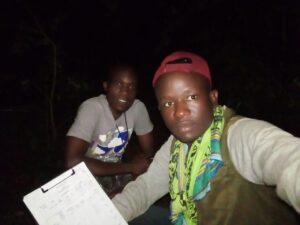Within Kilimambogo lies Kyeleni, an unexplored agricultural village. On 20th February 2021, the Nature Kenya Youth Committee embarked on a two-day mission to survey the biodiversity in this area. (Kilimambogo is also known as Ol Doinyo Sabuk.)
Our journey to the village took longer than expected. Despite being exhausted from the three-hour drive, the team eagerly anticipated its visit, unsure of what to expect. Mr Francis, our contact person, greeted us by the roadside and directed us to the camping area, which would be our home for the next 24 hours.
Upon arriving at the campsite, the team was divided into groups to ensure cooking was completed early, to allow more time for the evening survey. The groups were: team Ugali (funny how energetic the members of this group were), team Stew (the best cooks in the group), team Firewood (in charge of lighting the fire), and team AOB (in-charge of cleaning the cooking pots after meals).
Francis gave some members of the group a tour of his farm as lunch was being prepared. In the middle of his farm, not far from the camping area, was the main attraction – a mango tree. You can only imagine the excitement of the hungry group upon seeing this tree. Francis allowed them to pick some mangoes. He even went out of his way to harvest some maize for the team to roast before lunch.
You would be mistaken to imagine that after feasting on mangoes and roasted maize, only a few people would show up for lunch. There wasn’t a grain of rice nor a drop of soup left in the pots!
We converged at around 5 p.m. and went through some of the species present in the area, survey methods, and identification tools (iNaturalist, Makenya, and guide books) for use. We set out on our first survey, hoping to come across some interesting species.
Three hours into the search, we had spotted a few birds. Some of the birds had been identified by their calls. Darkness fell fast, and we retreated to the camping area.
After dinner, we gathered around a fire. The team was still going strong and decided to play a few games before calling it a night.
The following morning was chilly and quiet, with only the sweet melodies of birds heard. We started birding at 6 a.m. The bird experts in the group assisted the rest of the team with identification through calls. As the sun steadily rose higher into the sky, more birds became visible, making it easier to identify them.
Although no other species besides birds had been spotted hours into the survey, the herp and mammal lovers remained optimistic.
The day grew hotter, and we began to meet local residents who were puzzled as to why such a large group was in their village early in the morning. Francis explained that visitors from outside, particularly those interested in conducting research, were rare.
As we approached the foot of Mt. Kilimambogo, the team heard calls of excitement from within. “Come see a snake,” someone called. The snake enthusiast hurriedly rushed to the scene to catch a glimpse of the snake while others moved further away. To their amazement, it was a Cape Wolf Snake. Unfortunately, it was dead. A few meters away, the group came across another dead one: an Olive Snake.
The two snake sightings were the team’s highest moments. This energized us for the rest of the hike to the base of the mountain.
This survey would not have been successful without the continued support of Nature Kenya. In total, we recorded 32 bird species, two amphibians, and two snakes, with the prominent plant species being Euphorbia, Croton trees, and Sisal.

